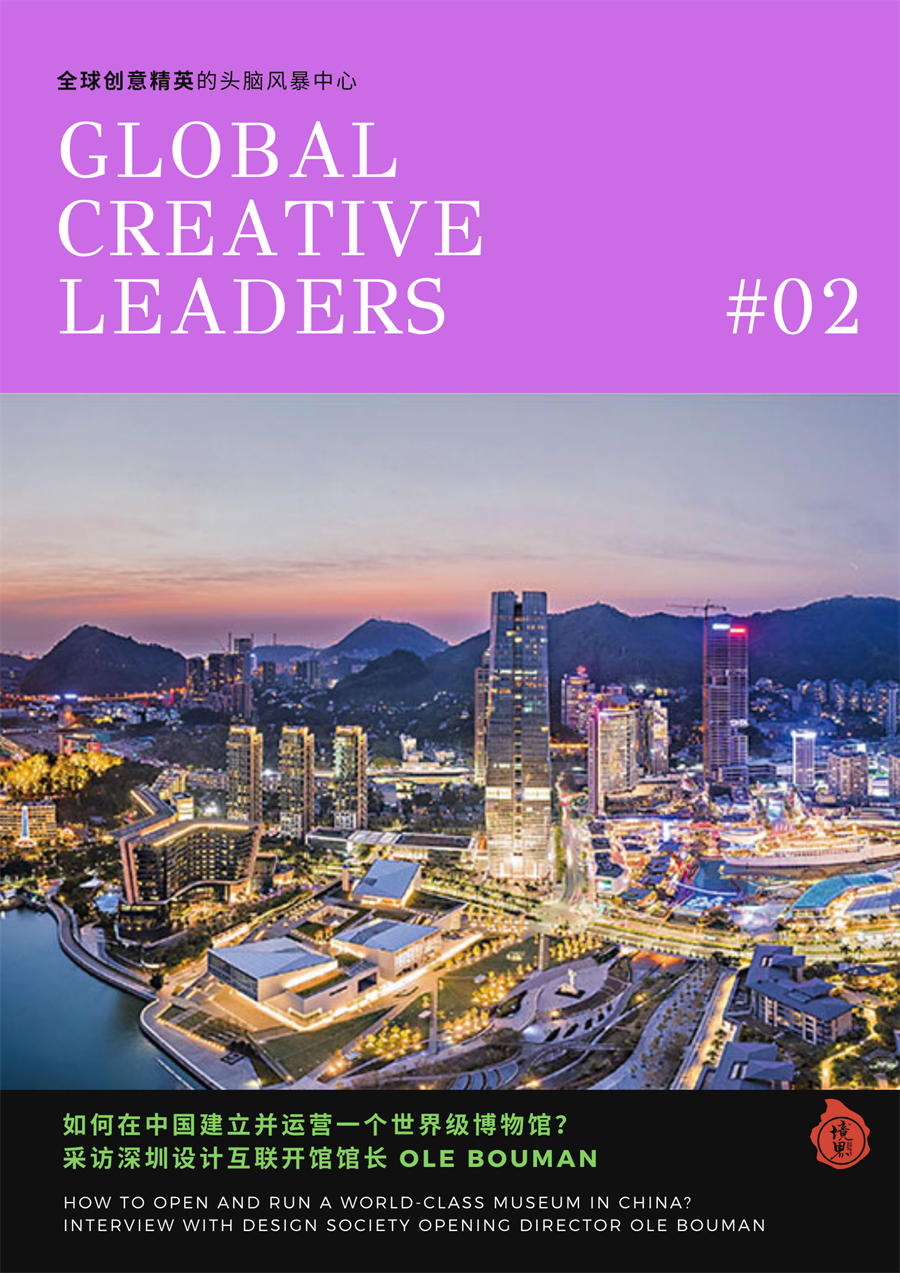
随着国内越来越多的博物馆开馆,展览内容的竞争也越来越激烈,试问哪个场地方不想多吸引观众来看,引发像故宫、卢浮宫等一样的现象级别的文化地标和IP呢?
而V&A作为世界顶级博物馆在深圳与招商蛇口集团在中国联合创办了的唯一文化机构,设计互联 DESIGN SOCIETY(运营机构)。
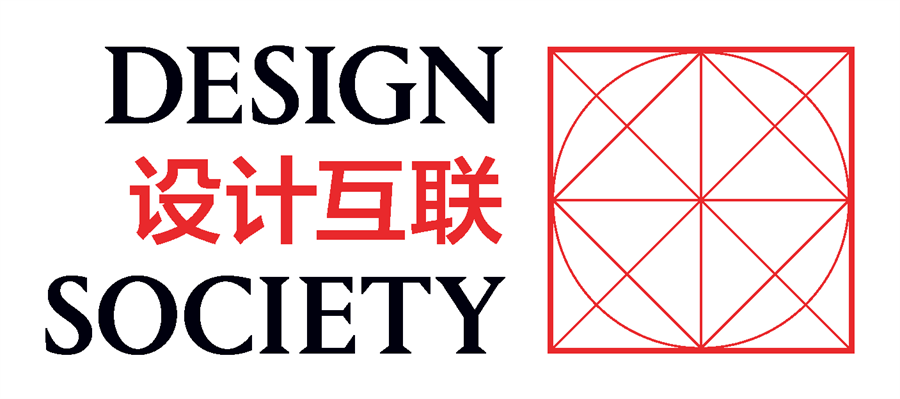
这次我们采访到了设计互联 DESIGN SOCIETY 的开馆馆长 Ole Bouman 先生,畅谈一下筹备一个世界顶级的博物馆是一种什么样的体验?
如何在中国建立和运营一个世界级博物馆?
How to open and run a world-class museum in China?
关键词:设计互联;英国国立维多利亚与艾尔伯特博物馆(V&A)在中国;荷兰建筑学会(NAi);荷兰新研究所(HNI);运营一个顶级博物馆;跨学科交叉设计;华丽派建筑与朴素派建筑。
Keywords: Design Society, V&A Museum in China, Netherlands Architecture Institute (NAi), Het Nieuwe Instituut(HNI),directing a top museum, cross-interdisciplinary design, flamboyant VS modest architecture.
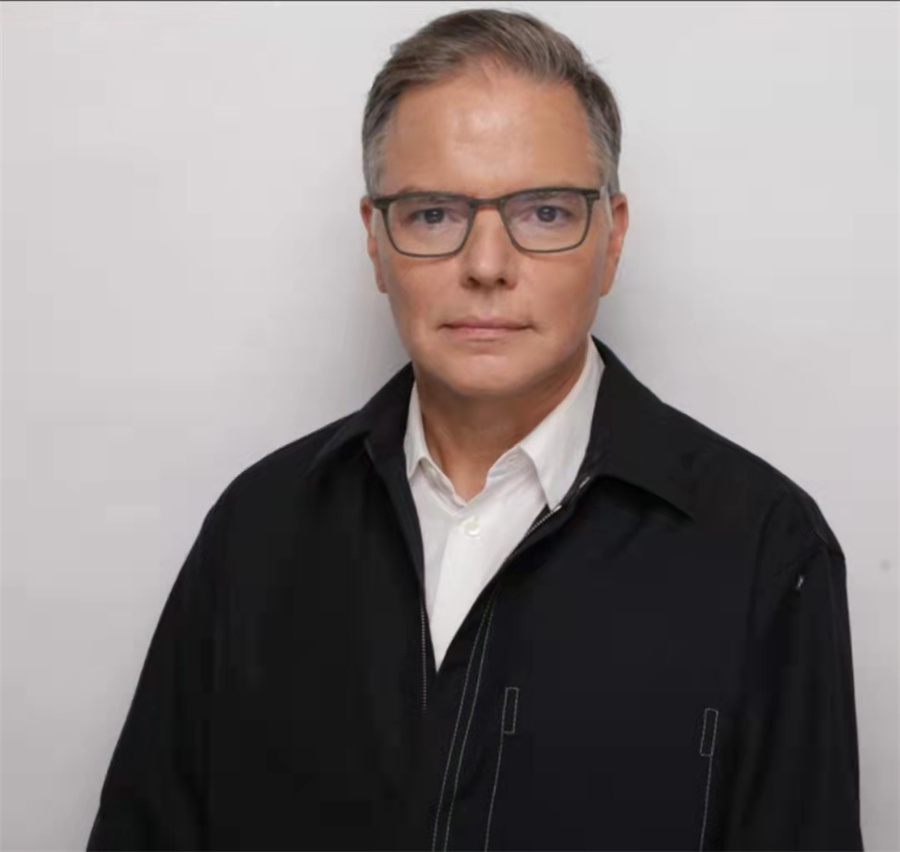
关于 奥雷 · 伯曼(Ole Bouman)
深港城市\建筑双城双年展(UABB) 创意总监(2013-2014),得益于他在创意领导方面的丰富经验,被任命为设计互联开馆馆长(2015)。他曾参与策划第十九届米兰设计三年展(1992-1996)、第三届欧洲宣言展(2000)、第十三与十四届威尼斯双年展(2012、2014)、圣保罗双年展等国际大型展览;并先后担任《Archis》(1996-2004)及其改版《Volume》杂志主编(2005-2007)、荷兰建筑学会(NAi)馆长(2007-2012)。还曾为美国麻省理工学院(MIT)、香港大学讲授设计课程,曾获2018深圳商报年度创意影响力人物奖项。
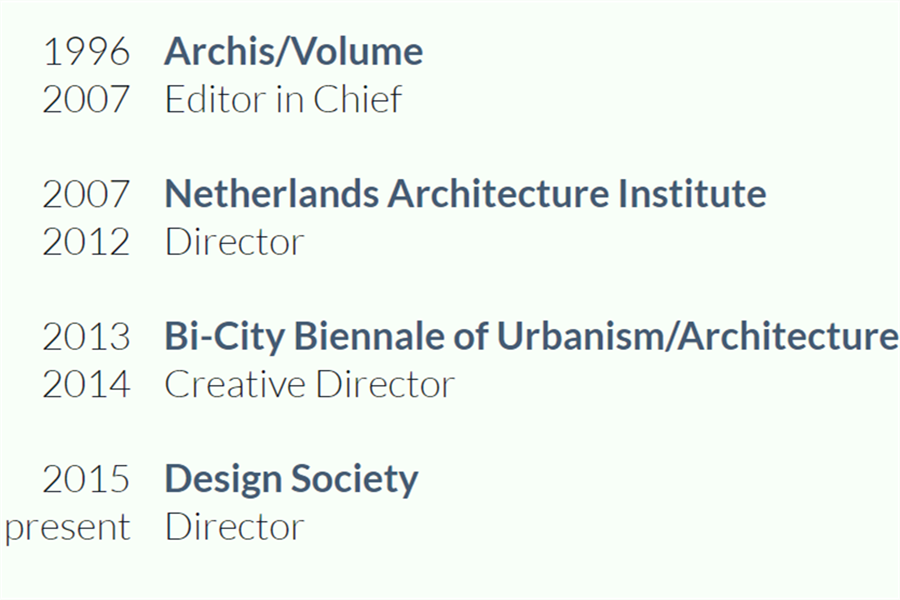
一分钟小科普
设计互联:设计互联是招商蛇口旗下创新设计聚合力平台,是由世界领先的艺术与设计博物馆——英国国立维多利亚与艾尔伯特博物馆(V&A)与招商蛇口在中国联合创办的唯一文化机构。通过促进人们对设计的认识、理解与享受,更新生活方式,提升生活品质。自开幕至今,设计互联已出品新工艺百物展《造物新世代》、数字艺术体验展《数字之维》、V&A馆藏精华展《设计的价值》、槇文彦五十年建筑设计回顾展《筑 · 梦》、探索中国漫画神笔飞驰的宇宙的《百年国漫大展》等大型展览,并携手多方创意人士与机构为公众带来多元的互动教育、创新体验与演出活动。
海上世界艺术中心:海上世界文化艺术中心由设计互联运营,是一处探索设计与艺术的新型目的地和文化新地标。总占地面积26,000平米,使用面积 71,000平米(6层楼),内含主展馆、V&A展馆、园景展馆、深圳联合国教科文展厅、境山剧场、小燕画院。
招商蛇口:招商局蛇口工业区控股股份有限公司(简称“招商蛇口”)是招商局集团旗下城市综合开发运营板块的旗舰企业,中国领先的城市和园区综合开发运营服务商,目前排名《福布斯》全球上市公司2000强第385位。
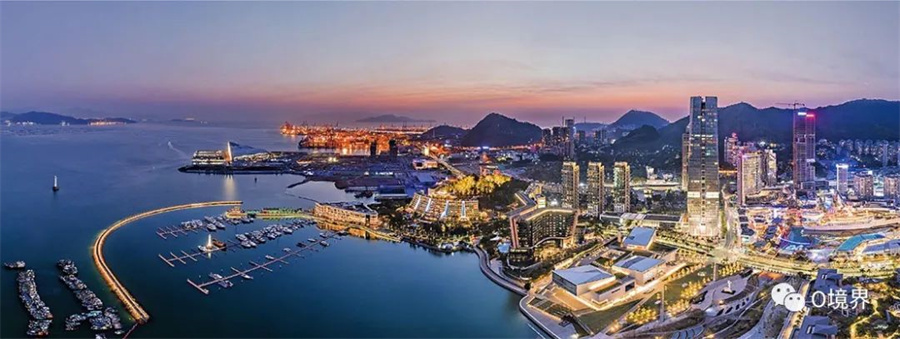
SWCAC 所在地的夜景图
Bird's eye view of the bay where SWCAC is at night
© 招商蛇口官网 Website of China Merchants Shekou
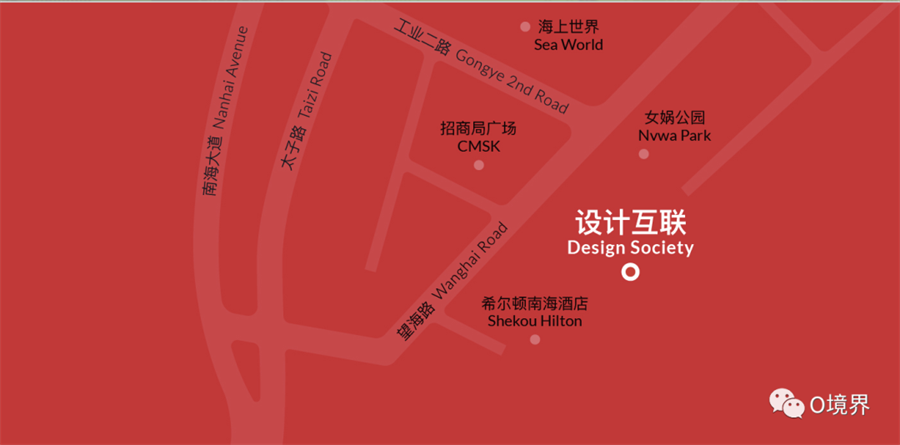
One-Minute Brief Introduction:
Design Society: Design Society is a platform which identity lies in its capacity to combine, connect, cross-fertilize and, by doing so, transcend cultural territories and boundaries as we know them. It is involved with many things, and at the same time it is clearly a new thing that requires its own name to go beyond the sum of its parts: hence Design Society.
Sea World Culture and Arts Center (SWCAC): Covering a footprint of 26,000 m2 with 71,000 m2 of floor space over six floors, SWCAC houses exhibition spaces at the Main Gallery, V&A Gallery, Park View Gallery and Shenzhen UCCN Gallery; multipurpose event spaces as the Mountain View Theater and Horizon Hall; educational institutes like Xiaoyan |NEXT and the Art Education Center of the National Ballet of China and so on.
SWCAC was designed by Fumihiko Maki as his first building in China and operated by Design Society.
China Merchants Shekou: China Merchants Shekou Industrial Zone Holding Co., Ltd. (hereinafter referred to as "China Merchants Shekou") is the flagship enterprise in China Merchants Group's urban comprehensive development and operation sector. It is a leading comprehensive development and operation service provider for cities and industrial parks in China. Currently, it ranks 385 out of 2000 among Forbes Top Global Listed Companies.
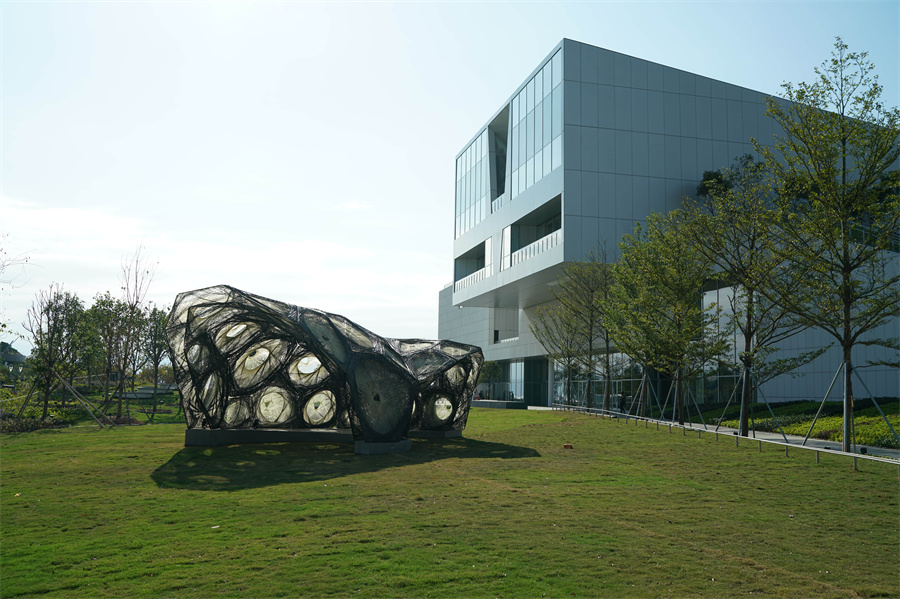
Q1:筹备一个国际顶级博物馆需要做哪些准备工作呢?而且不是普通的博物馆,是V&A这样顶级的博物馆——作为深圳海上世界艺术中心的一部分,如何保持展览国际内容和水平的同时,很好地融合当地的特点和活力?
What does it take and feel like to prepare for the opening a top-tier international museum in China? Not just ANY museum, a museum that is an institution, including a V&A gallery in China in Sea World Culture and Arts Center, how to maintain the world-class level of museum operation while make it a contextual museum with local characteristics and vitality?
A1:也许更重要的是整理出未来所有者,客户和决策者的愿望,并在这些条件做到最好规划和方案。当我到达深圳开始为设计互联展开基础工作时,客户是一家国有企业——中国招商蛇口控股(中国招商局集团的一个子公司)。之后需要充分了解这样一家资产分布在诸多不同行业的国企想要建立这样一个文化组织是怎样的想法。而且这些想法常常与私人博物馆的个人藏家的动机截然不同。我还必须了解关于选址的诸多信息。这座新博物馆坐落于深圳蛇口区,这里具有很高的经济水平和社会活力,同时承载着历史的厚重感,可以说,它是中国面向全世界开启改革开放的伟大时代的一个象征。
还有一件事我需要研究的是招商蛇口和本项目的建筑师——知名普利策奖获得者、日本建筑师槙文彦——之间已经建立起的关系。我需要理解它并深化双方的对话,确保博物馆项目完全嵌入并和谐地融入到整体的建筑设计中去。在设计工作中这也很重要,因为我们的主要合作伙伴是V&A博物馆,他们设定了一个非常高的博物馆(软硬件的)标准。所以我们需要确保高标准的建筑设计与高标准的博物馆学之间能够相得益彰。我们需要按照V&A的规定来经营博物馆,因此,必须注意博物馆愿景和建筑愿景之间的这种平衡。
最后,有一个关注点我需要特别地提一下。就是这样一个新机构的未来专业观众的心理预期,我必须了解这些期望是什么。最后的最后,我是带着自己过去的经历和经验参与到这个项目的筹备过程中来的,所以,在筹备的最初 阶段,必须将这么多不同的能量整合到一个统一的愿景中。这是第一个阶段,实际上是协同所有周围的正能量,并确保有一个在现实中可以执行的计划。因此,从愿景到计划再到实践的转变,是建立博物馆的第一阶段。
然后,在筹备的第二阶段,非常重要的是,要确保它确实可以落地。“谁来资助这个项目,谁会喜欢这个,谁来讲述这个故事”等,这类的问题需要落实。所以需要建立一个团队,建立工作流程,建立一个博物馆所需的(各个工种的)工作范围、职位描述、人才搜索、营销,可以帮助讲述故事的团队,等等。然后,在最后阶段,要确保与这支组建起来的团队协作,让这个团队发挥最大的力量,并让所有计划得以执行。所以需要准备一系列的开幕展览、宣传活动。总体而言,当这座建筑都筹备妥,当你感觉到准备好了可以开门迎接参观者时,你会觉得这样就可以了,是吗?但其实离接待游客还为时尚早。
Perhaps even more important is to sort out the aspirations of future owners and clients and decision makers and to do the best (arrangements and schemes) under these conditions. When I arrived in Shenzhen to start laying the groundwork for Design Society, the client was China Merchants Shekou holdings (subsidiary of China Merchants Group), a state-owned company. And it was necessary then to fully understand what they had in mind in establishing such an cultural organization, as part of a company with assets in many different industries. And the motivation for these startups is always different from that of a private client or an individual collector who wants to set up private museums. I also had to understand a lot about the location. This new museum started in Shekou, an area in Shenzhen, with a very high economic and social dynamic, as well as very heavily laden with history, you could say, culminating as symbol of China's great era of reform and opening up to the world.
Another thing I had to explore was the existing relationship between Merchants Group and the renowned Pritzker Prize winning Japanese architect Fumihiko Maki, who is the architect of the building. I felt the need to understand it, to deepen the dialogue between them, in order to ensure the museum program is fully embedded and integrated in the project. This was also important because our main partner, the V&A Museum, has set a very high standard for museums. For this reason, it behooved us to have the architecture complement the high standards of museology.
To this end, operating museums in accordance with V&A regulations requires the harmonious intertwining of visions between architecture and museum. Finally, there were a number of other concerns, one of which being the expectations of the future professional audience of a new institution such as this. On top of that, I felt it was incumbent on me to understand what these expectations were. Finally, I brought my own past experiences to the preparatory process. So in the beginning, many different energies had to be integrated and forged into a single vision. The first step was actually to focus all the positive ambient vibes so as to ensure the plan could be implemented.
Hence the initial phase in establishing a museum inevitably involves the translation of vision to plan to practice, while the second phase of preparation wants to make sure that it actually can happen. Questions as to“Who will fund this, who will like this, will tell the story”will need to be addressed. First and foremost, you need to build a team, establish the appropriate workflow and work scope required, mine the necessary talent and whatever else it takes to help tell the story effectively, so on and so forth. Subsequent to this is the final phase, which involves setting the assembled teams up to succeed by bringing out their level best, and implementing all the plans accordingly. In turn, preparations for a whole series of opening exhibitions and promotional campaigns are to follow, as the building in general is being readied for prime time. When you sense you are ready to open your doors you will feel a sense of relief, right? But it's still too early to receive visitors.
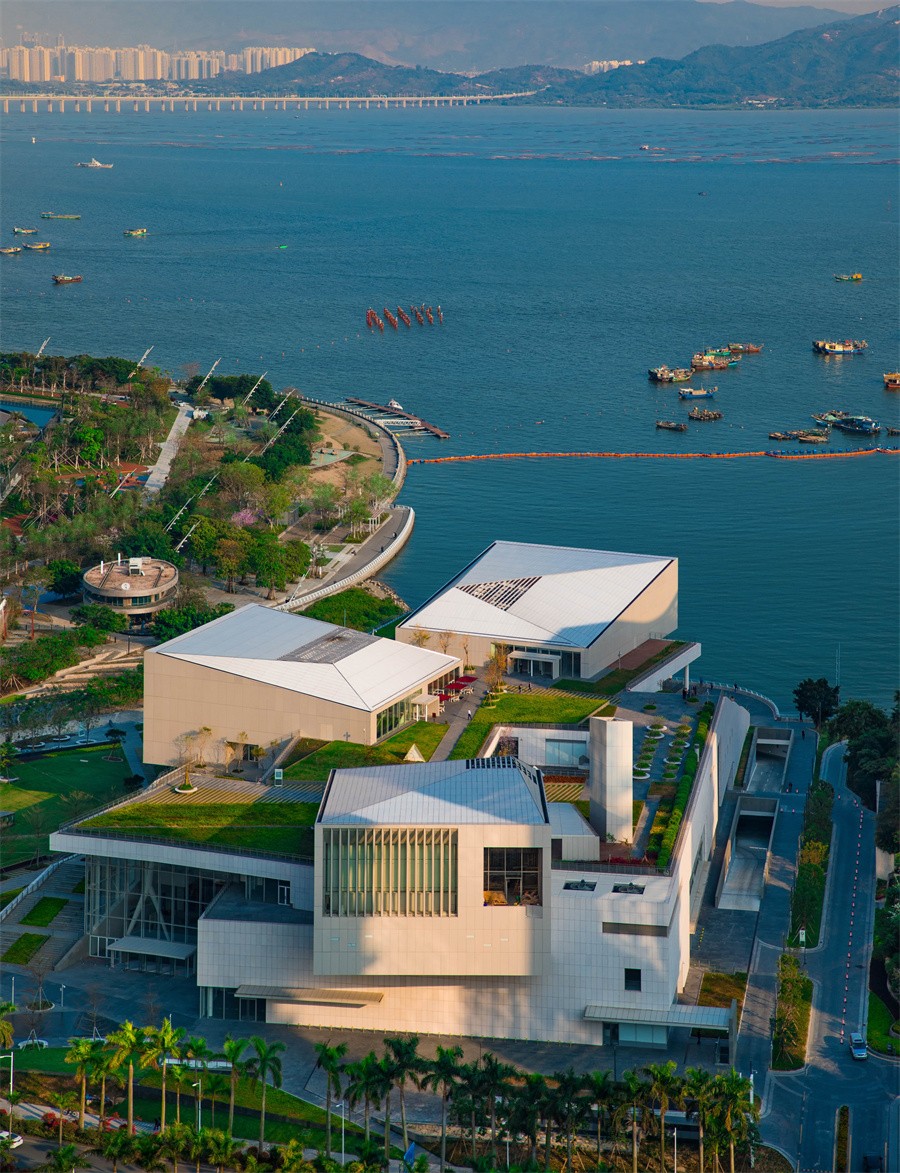
Q2:对于这样的博物馆,在准备开业与正式运营之间,最大不同是什么?
What are the biggest differences between preparing and running such a museum?
A2:总的说来,这基本上都是关于从供应到需求的转变。开馆第一年,需要确保馆内有一些优质内容可以提供给观众。但是在下一个阶段,必须确保有市场需求。因此,您必须了解您的受众并与他们接触,必须确保他们能找到这个地方、对馆内的活动有一定的参与感、有一种期待的心情,并有意愿成为会员,等等。这种冲动几乎是一种心理上的东西。能够在受众群的脑海中创造那种去看看的冲动是准备开幕和准备好接待观众之间的最大不同。
Generally speaking, it is basically all about the shift from supply to demand. The years before opening you are supplying; be sure that you have high quality content to offer. However, afterwards, have will have to make sure there is demand. For this you will have to learn about your audience by reaching out to them. You have to make sure that they find their way to the place, to the brand, to the mindset, to the activities, and to feel a certain urge to participate to them, to become members and so on. This impulse is almost a psychological thing. Being able to instill such impulse in the minds of the audience is the biggest difference between being ready for the opening and being ready to receive the audience.
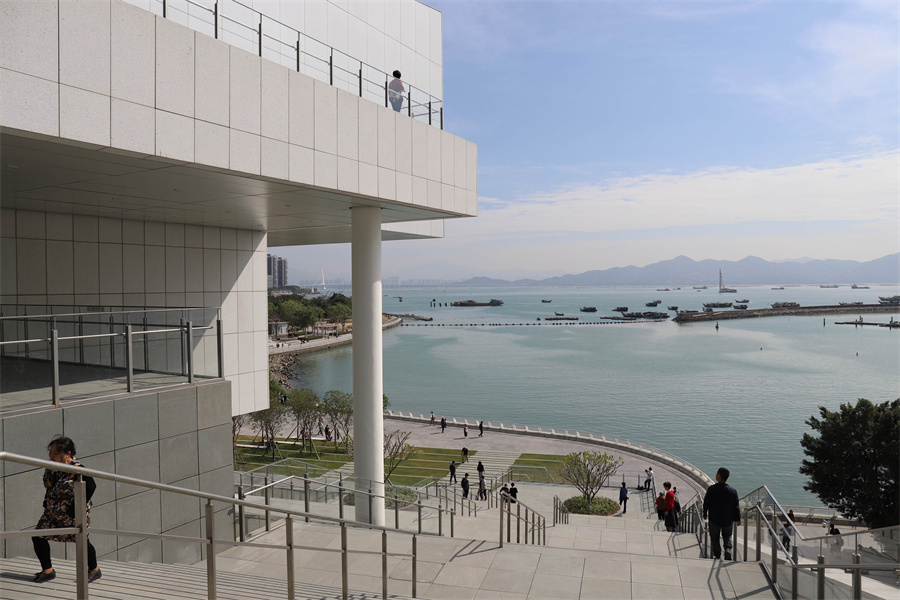
Q3:您曾经是(前)荷兰建筑学会( NAi )的馆长(2007-2012)和设计互联(与V&A合作的中国项目)的创始馆长,您参与过运营和筹备国际顶级博物馆,您更喜欢哪个部分呢?
You were the director (2007-2012) of then Netherlands Architecture Instituut (NAi) and founding director of Design Society. You were involved in both opening and running of top international museums, which part do you enjoy more?
A3:我认为,将梦想变为现实是最令人兴奋的事。如果你只是做梦,那可能是一个美丽的梦,但它仍然是一个梦。但如果你能确保梦想成真,那就更有意义了。比起完成一份文件,看到一群青少年从学校出来,在博物馆里欣赏展览,几年后决定学习设计…… 后者这个过程,我觉得更美好。整个过程作为一个创作周期,是极具回报和成就感的。
I think the most exciting thing is turning dreams into reality. If you only dream, it may be a beautiful dream, but it is still a dream. But if you can make the dream come true, it is much more rewarding. Compared to finishing a document, it is more rewarding for me to see a group of teenagers enjoying an exhibition in the museum, after class, and decide to learn design several years down the road. The entire process as a creative cycle is most rewarding and fulfilling.
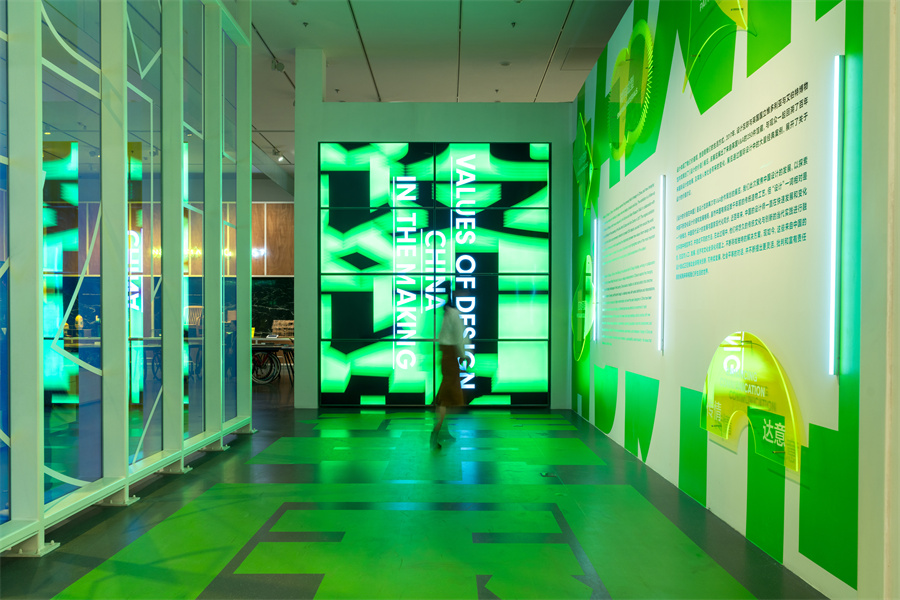
设计互联自主策划展览《设计的价值在中国》 Value of Design Exhibition in China curated by Design Society©设计互联 Design Society
© V&A 官网 V&A website
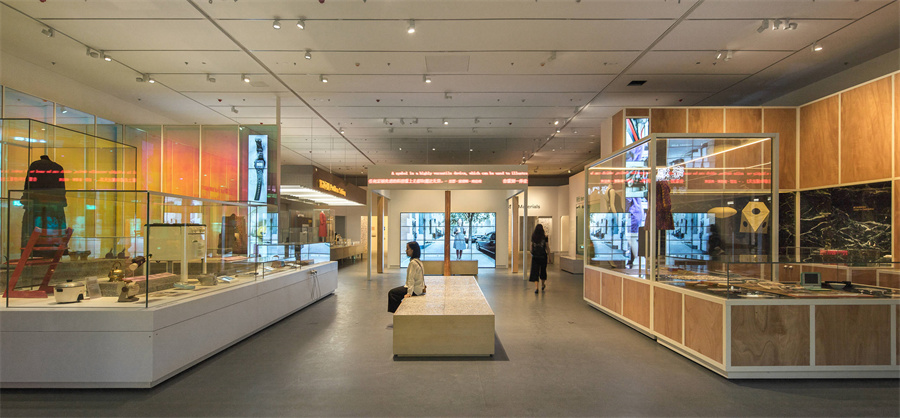
Q4:说到不同类型的工作,如出版书籍和文章、策划展览、运营博物馆,您做了这么多跨创意专业的工作,您最感兴趣的工作是什么?您是如何将所有这些学科有机地结合在一起的呢?
When it comes to different types of work--publishing books and articles, planning exhibitions and guiding museums, you have done so much inter-disciplinary work as a creative professional. what kind of work interests you the most? How do you juggle and organically combine all these disciplines together?
A4:这么多活动或者学科,我觉得也可以不把他们看成是不同的事情,只要能抓住这些事情的重点。所有这些活动实际上都是媒介,它们串联起我的信念和最近的想法。而在现实中,这个串联的媒介有时你需要一个博物馆、有时你需要一本书、一个研讨会或一个会议,或者将设计工作室作为一种媒介来贡献出你的价值。因为随着社会的发展,你所作的贡献也会随之发展,这取决于什么样的工作是最适合、最有效的。 所以当你说 “你做了这么多不同种类的创意工作”的时候,我认为你是在夸奖我。这种每次都在不同的领域工作,关键是建立一定的专业认知度,让经验增长。如果你想有影响力,就不能仅仅做一种事情,因为现实是在随时改变的,所以你需要一直改变你对现实的贡献的内容及方式。
You don’t need to see them as different, as long as you see the focus of them. All these activities are in fact media that mediate between my beliefs and ideas essential for today. In reality, sometimes you need a museum for that. Sometimes you need a book, or a seminar, or a conference. Or use the design studio as a medium to contribute your value. Because when society evolves, your contribution can evolve as well, depending on what kind of work is the most suitable and most effective. So that's why I think you are praising me by saying “you have done so many different kinds of creative work. The key is to build a certain professional awareness in different fields every time and let experiences grow.
If you want to be relevant, you have to do more than just one thing. Because reality changes, so you need to constantly modify or change your contribution as reality dictates.
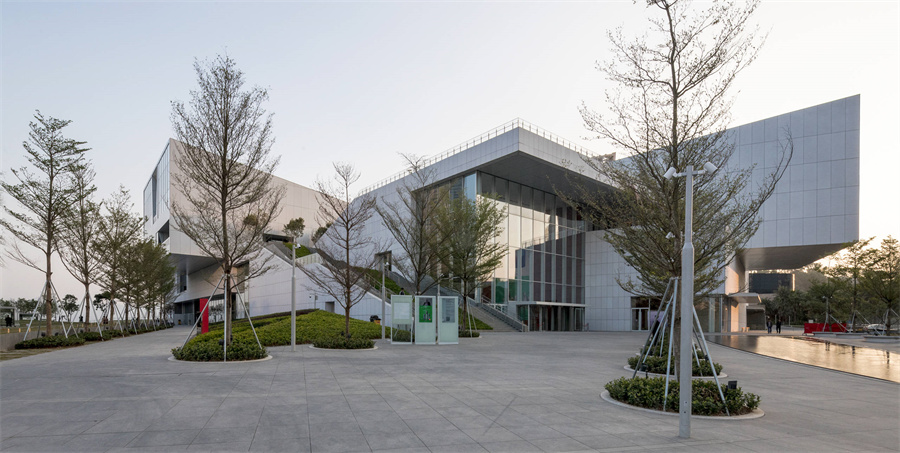
© V&A 官网 V&A website
Q5:在NAi与Premselar合并后,也就是当建筑与时尚设计、数字艺术相融合时,这些不同的学科是如何融合在一起的?是相互矛盾还是相互补充?可以举个例子吗?
After NAi merged with Premsela, that is, when architecture was integrated with fashion, design, digital art, can you think of an example of how these different disciplines come together, whether contradict or complement each other?
A5:NAi和其他两个创意机构合并为一个新机构,现在叫做新研究所Het Nieuwe Instituut (HNI) ,是国家政府主导的事情。这其实很简单,政客们普遍的想法是 “我们不需要专门针对某一创意学科分支的政府机构,而需要一个机构来支持整个创意产业,他们称之为荷兰经济的“顶级部门” 。培育这个“顶级部门” ,是文化部的心愿。我不认为这是支持国家创造力的最好方式,但我尽力做到最好,(作为馆长)必须将这种政治意图转化为文化意图。
原先作为建筑文化机构的负责人,我对建筑与设计和数字媒体的结合已经了然于胸,因为建筑本身在西方已经与应用艺术、室内设计以及家具、照明和景观等学科有多年的交叉和合作,有令人难以置信的紧密联系。显然,这里的建筑概念比仅仅建造建筑物实体要大得多。在过去的 20 到 30 年里,建筑从仅仅建造硬件、建筑本身,转变为设计我们的体验,包括我们在数字领域的体验。作为一门学科,建筑已经非常开放,完全可以接受其他两个机构带来的新内容。所以从这个意义上说,创办一个格局更大并实际上与 NAI和谐合作的机构并不奇怪,我们做这件事已经很多年了。
举个例子,当我担任NAi的主管时,前任主管Aaron Betsky留下了一份尚未实现的意愿。他曾向一位著名建筑师许诺,要举办一场关于他作为建筑师的作品回顾展览。但是我不想再做针对个人的专题展览,或者我不觉得用国家级别的建筑学院来宣传一个活生生的人是一种正确使用公共资源的方式,这对其他建筑师来说是不公平的,这对于建筑学科来说也是不公平的,它(建筑在大多数的时候)不是只有少数大师的作品,更多的是和不同专业的团队合作为导向和主体的。
所以我和这位建筑师谈过,我说: “我们不会专门展示你的建筑作品,但我们会邀请你在主厅内设计一个展台。”所以他仍然可以通过设计一个可以在整个展览期间奇妙变换的可移动的舞台来展示他最好的设计水平。这将成为一个非常开放多变的舞台,在 90 天里每天都在那里, 尤其是每天晚上在舞台上都有不同的现场表演,芭蕾舞演员、音乐家、厨师、派对组织者等都有机会使用这个舞台。每天晚上现场的形象也完全不同,我们称那个展览为“ Happening ”。实际上,就像在现实生活中一样,生活总是高于实际的建筑物的。你看,这已经表明我们的建筑师可以在展示自己的专业能力和建筑的最佳“打开方式”上非常开放,我们可以同时与不同的受众互动,这不是关于建筑的形式,而是关于其功能的。
从这个例子上看,知名建筑师也回到了工作本身,而不是专注于名声和营销,是关乎一个人能做什么,实际上是使这个人与其他人群不同之处。这才是正确的做法。
The merger of NAi and the other two institutions into one new Institute , or even just Het Nieuwe Instituut (HNI), was provoked by the the national government. It was actually very simple. A prevalent idea among politicians, that “we don't need a state institution dedicated to a single discipline. We need to an Institute that supports the creative industry as a whole, a so-called“top sector” of the Dutch economy. Cultivating this “top sector”was the wish of the Ministry of Culture. Inasmuch as I don’t believe this is the right way to support national creativity, I have tried my best to turn this political intention into a cultural one.As the head of the architecture institution, I was already completely at ease with the combination of architecture and design and digital media, because architecture itself has already been doing that for many years. Architecture has an incredibly strong connection with the applied arts, such as interior design, as well as furniture, lighting and landscape design. It also has been completely entangled with our digital life, from design process, to the experience of our daily environment. Obviously, architecture is much more than just making buildings; it cuts across many scales, including the smaller, and digital scales of design.In the past 20, 30 years, architecture has shifted from just building the hardware and the building itself, to designing of experiences, including our experience in the digital domain. As a discipline, architecture has been quite open-minded as a discipline to the input of the other two. So in that sense, it's not surprising to have a larger institution broaden its scope and actually dovetails harmoniously with NAi. We have been doing it for many years already. For example, when I arrived as a director of the NAi there was an unfulfilled legacy left by the former director, Aaron Betsky. He had pledged to a famous architect to hold an exhibition of his work. But I didn't want to do any more special monographic shows, for I didn't feel it was right to use public resources as a national architectural Institute to promote the work of a living individual. It would not be fair to other architects. Nor would it be fair to the discipline of architecture, which is a much more versatile and team oriented endeavor than merely the works of a few master minds.So I talked to this architect and said, “We are not going to show your work, but we will invite you to design a display stage inside the main hall.” So he could still showcase his best skills by designing a movable podium that could be magically transformed throughout the exhibition. And that would serve as a stage for a very open-ended program, where every day and especially every evening saw different live performances taking place on that podium. We call the exhibition “Happening”. So for 90 days, there was the opportunity for ballet dancers, musicians, cooks, party organizers and so on to use that podium. And every evening the image of the scene was completely different.In fact, in real life, life always takes over the actual buildings. You see, this goes to show that we architects could be very open showcasing ourselves and focusing on best aspects of architecture, which is not about form but about performance. We can engage with different audiences at the same time. In this case, well-known architects also return to the work itself,rather than focusing on reputation and marketing. It's what you can do that actually sets you apart. That's the right thing to do.
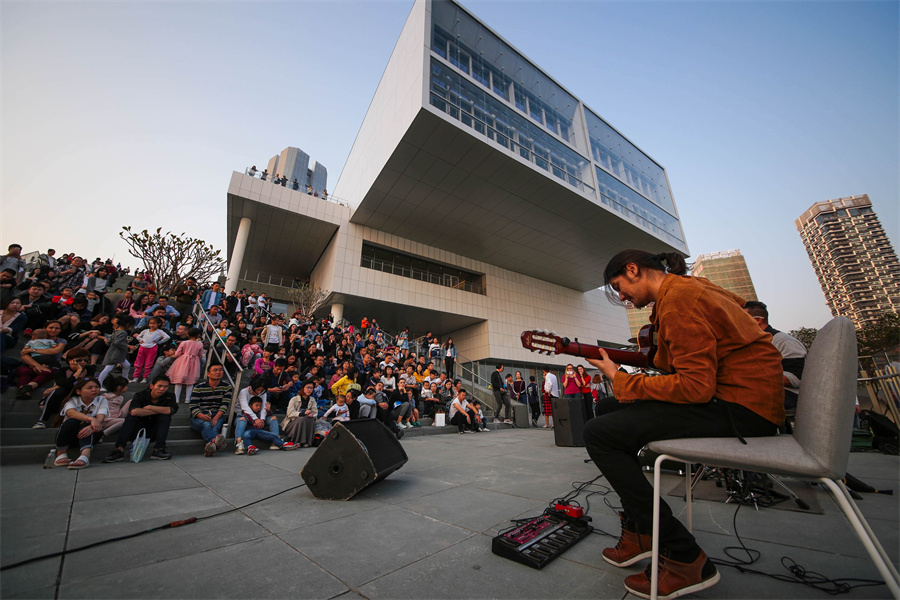
![]() ©设计互联 Design Society
©设计互联 Design Society
Q6:如果建筑师(的审美和价值观)也可以分为两个极端,一端是华丽的,一端是朴素的,我是否可以推测您更倾向于后者呢?
If the spectrum of architects span two extremes, from flamboyant to modest, am I right to assume you lean more towards the latter?
A6:是的,只有当华丽本身成为唯一一个目的时。但这两者并不一定相互排斥。历史上有许多建筑实现其功能的同时,也深受人们的喜爱。同时,也有的设计可能是朴素的,但仍然让他们的创作者们声誉尽失。
也许历史上最好的建筑经典是将这两个维度以优雅的方式结合在一起的作品。想一想Alvaro Siza,Rafael Moneo 的作品,或者像 Hans Scharoun,Aalto 等早期的项目。
Yes, only if flamboyance becomes a goal in itself. But the two are not necessarily mutually exclusive. There are many examples through the history of architecture that fulfil their functions while also highly popular. Meanwhile, they may be modest in design and still discredit their creators.Maybe even the best examples of architecture across history are works that combine these two dimensions in an elegant way. Think of the works of Alvaro Siza, Rafael Moneo, or earlier examples like Hans Scharoun, Aalto etcetera.
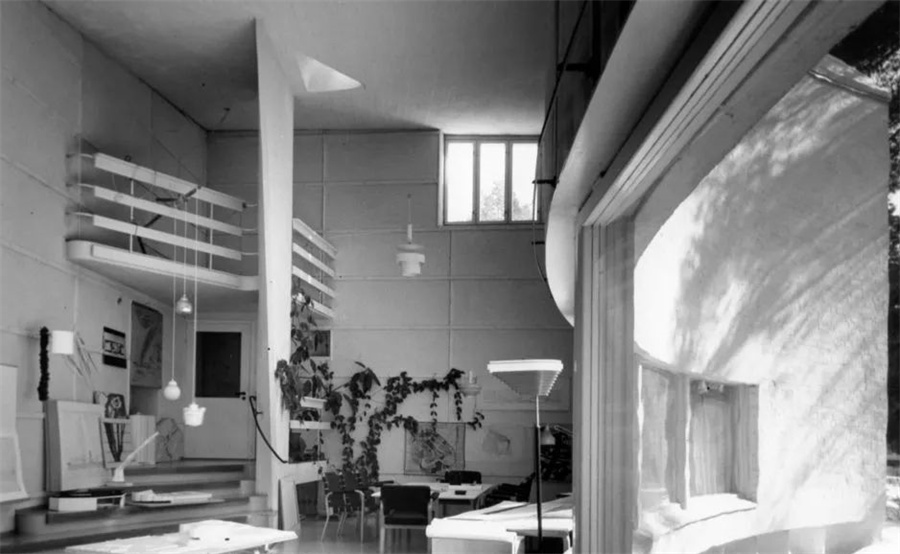
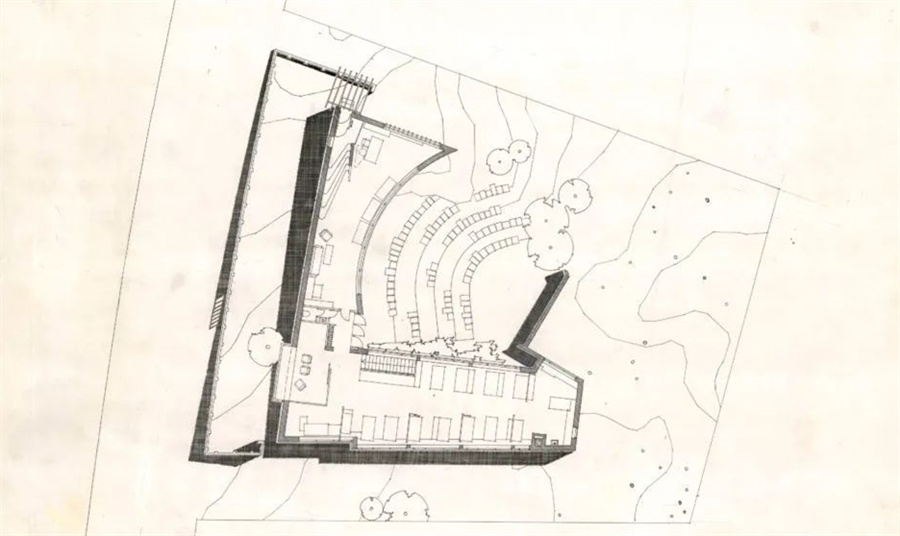
Alvar Aalto 自己的建筑工作室Studio Alvar Aalto design office© Alvar Aalto 基金会 Alvar Aalto foundation
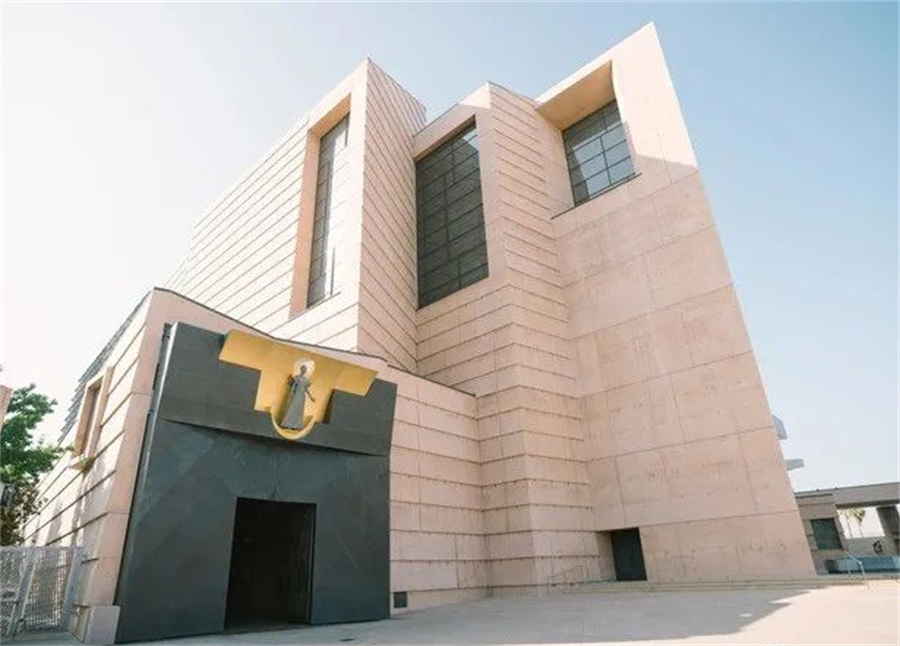
Rafael Moneo 先生的知名项目,位于洛杉矶的天使之女天主教大教堂
One of Rafael Moneo renowned projects, Cathedral of Our Lady of the Angels located in L.A© 该教堂官方网站 official website of Cathedral above
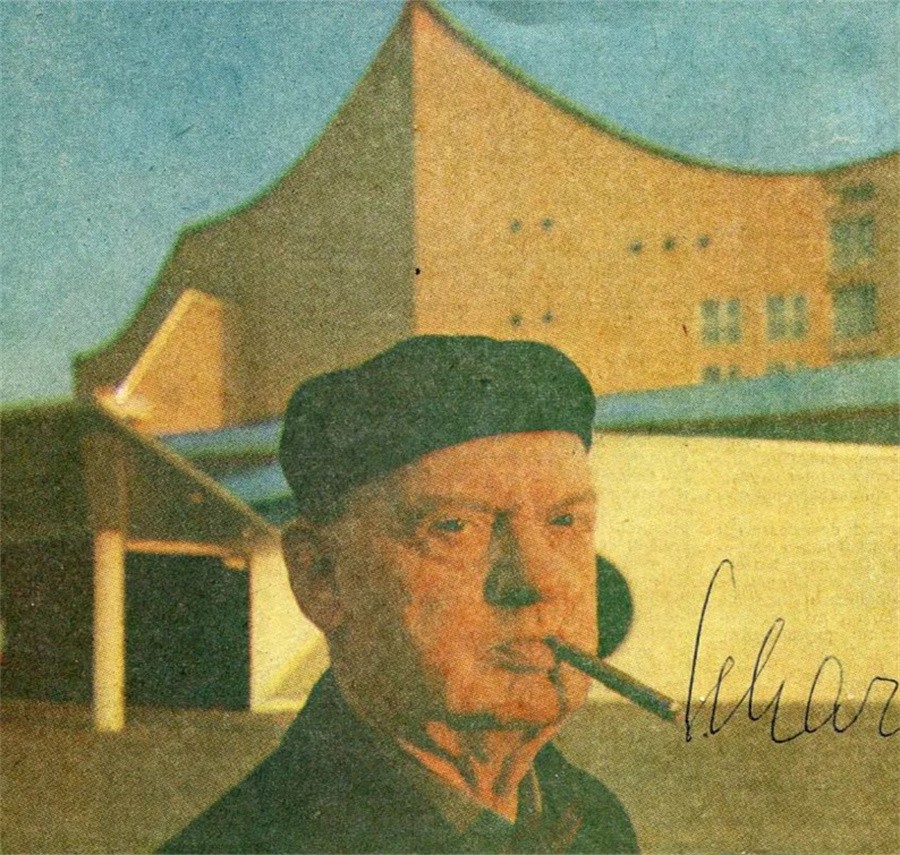
爱乐乐厅是汉斯 · 夏隆倡导的未来主义有机建筑的代表作,夏隆赢得爱乐乐厅设计竞赛的头奖,也是最深受德国人喜爱的建筑之一,在战后的德国现代建筑中占有非常重要的地位。
The most representative work of futuristic organic architecture advocated by the noted German architect, Hans Sharoun, is the Philharmonic Hall in Berlin, Germany, which he won in a design competition. As one of the most popular buildings in Germany among design professionals and the general public alike, Scharoun's interpretation occupies a very important position in post-WWII German modern architecture.
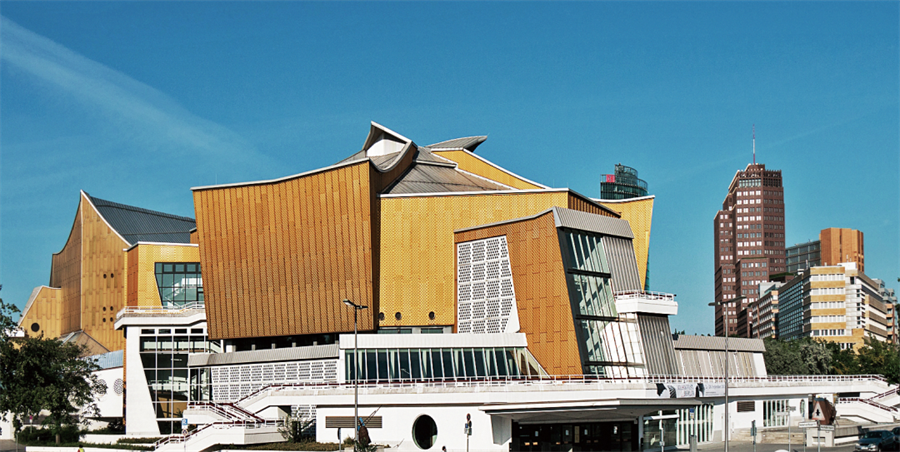
![]() © 有方 Youfang
© 有方 Youfang
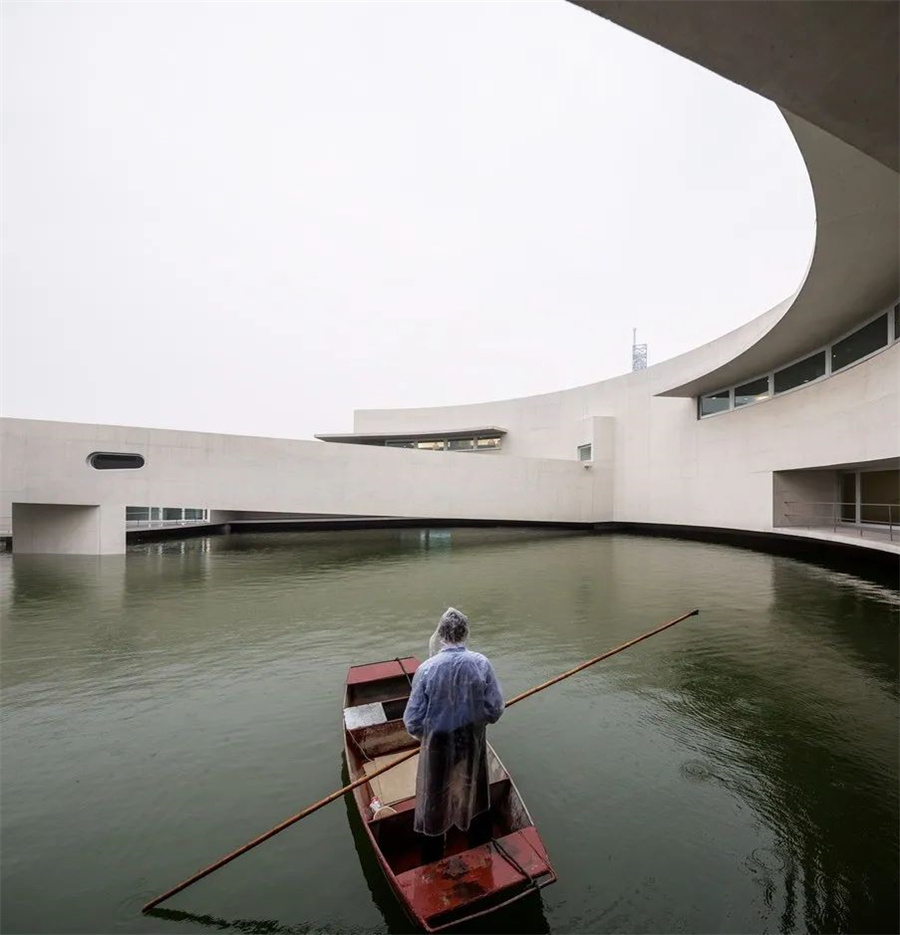
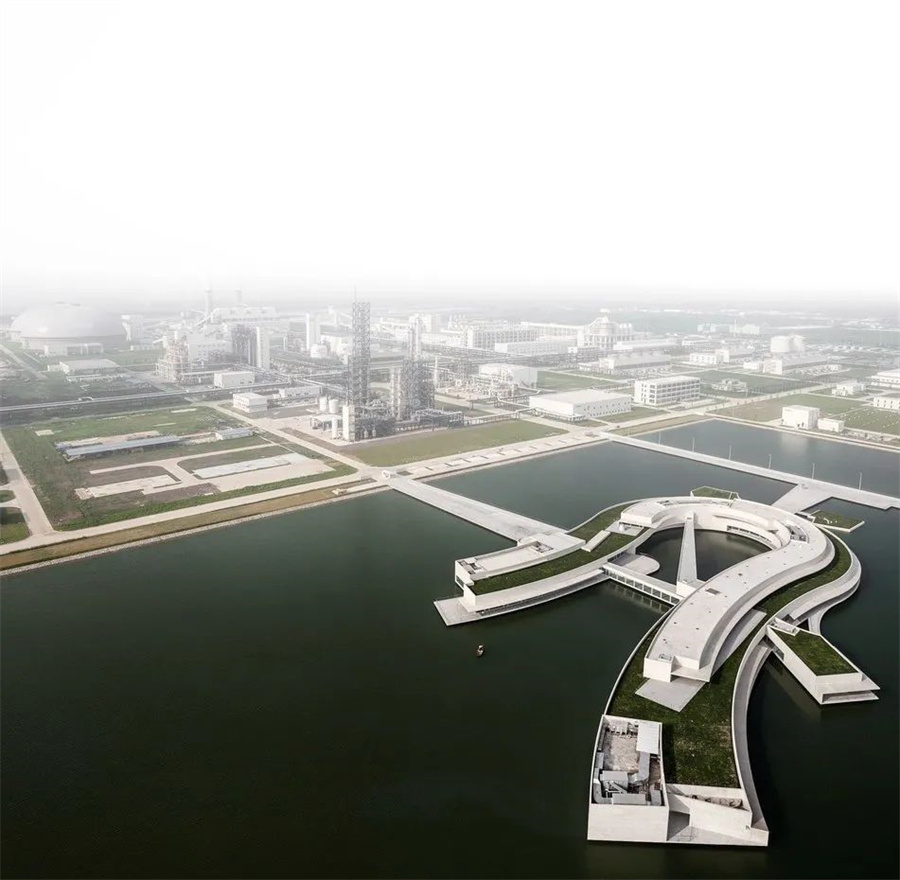
国际建筑大师 Alvaro Siza 之中国首座建筑作品,坐落于中国江苏省淮安市盐碱科技产业园实联化工(江苏)有限公司之“实联水上大楼 ”于2014年正式启用,该企业是一座全球标竿性的联碱生产工厂。
The inauguration of “The Building On the Water” of the Shihlien Chemical plant in Huai’An City, Jiangsu Province, was held in 2014. This is the first work unveiled in China by celebrated architect and 1992 Pritzker Prize winner Álvaro Siza. 费尔南多·格拉 | FG+SG 工作室 Fernando Guerra | FG+SG
Q7:在“未来城市”这个话题上,大概是在10年前您的老友博埃利先生现在在米兰建起了“垂直森林”这个项目,到去年建成的Thomas Heatherwick 的“天安千树”,到博埃利先生在湖北黄冈的居然之家垂直森林大厦,您对这种项目的看法如何?
On the topic of future city, it has been 10 years sharp since your old friend Mr Stefano Boeri created “Bosco verticale”in Milan. This year Mr Boeri’s vertical forest EASYHOME building in Hubei province is also finished. 1000 TREES in Shanghai, by Thomas Heatherwick in 2020. What do you think of this type of project?
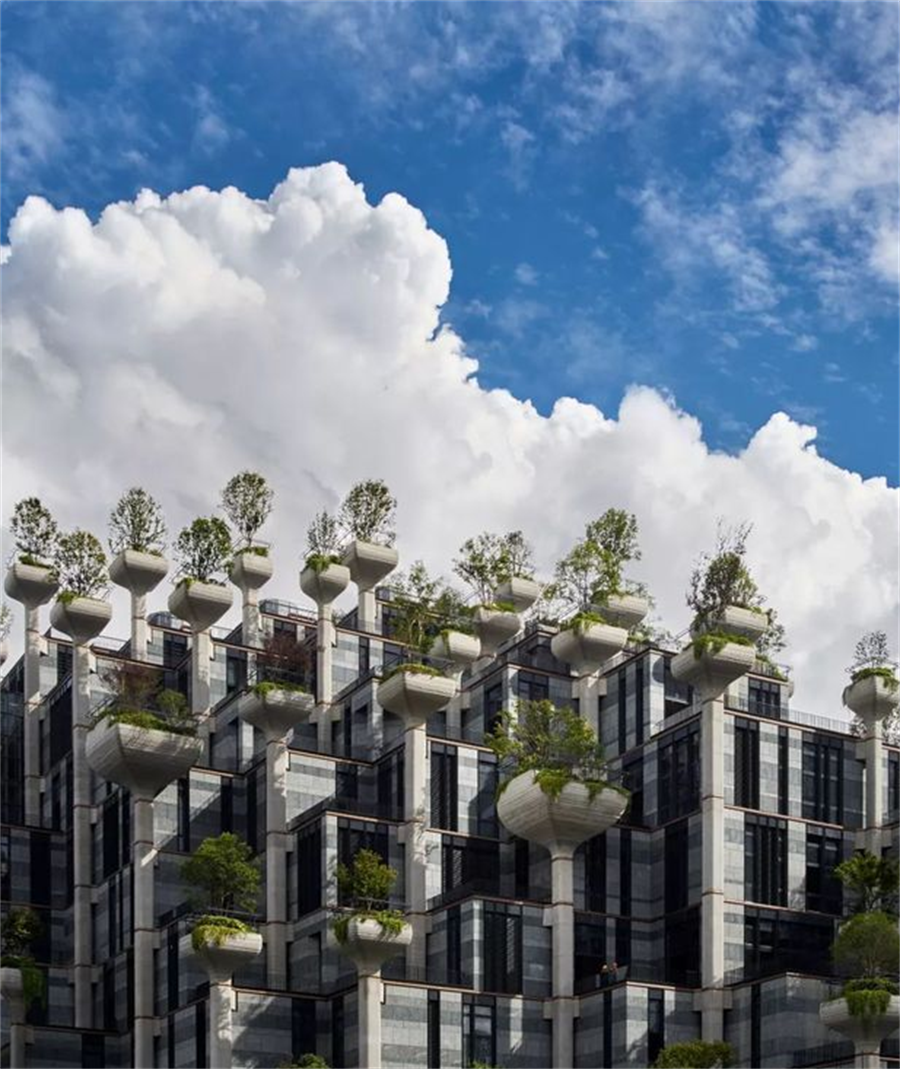
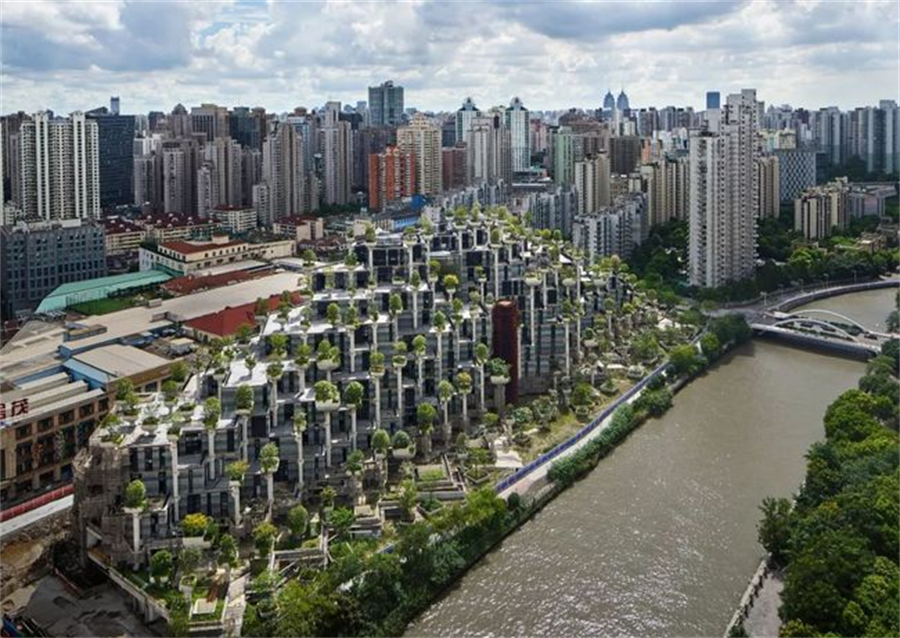
托马斯·赫斯维克设计的”1000 Trees” 空中花园项目也叫“天安阳光广场”,位于上海市的苏州河畔、M50艺术区附近Designed by Thomas Heatherwick, the project “1000 Tree” also called “Tian An Sunshine Square”, located in Shanghai, on the Suzhou River bank, near M50 Art district © 网络 internet
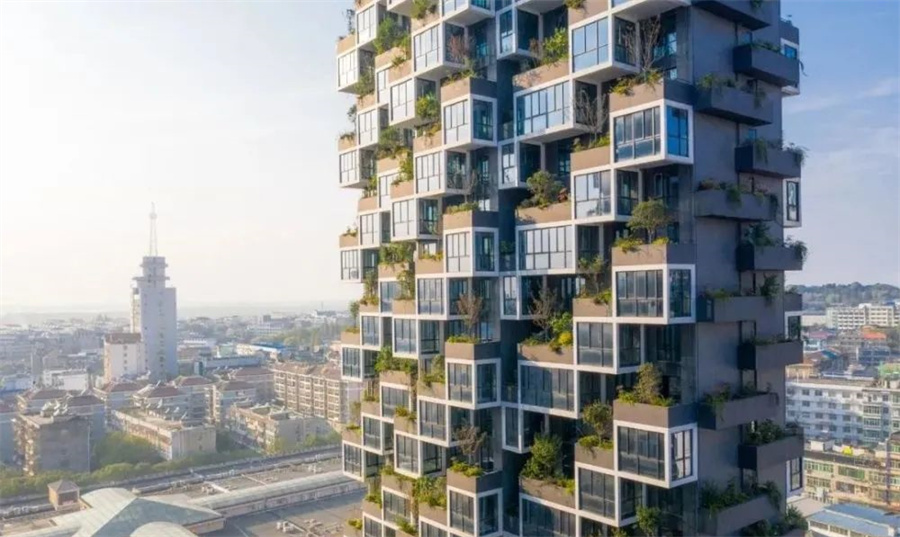
居然之家黄冈垂直森林城市综合体位于湖北省黄冈市,是由博埃里建筑设计事务所(中国)在中国建造的第一座垂直森林,已于2022 年1 月全部完工并迎来了它的第一批住户Designed by Stefano Boeri, the first vertical forest building in China, also an EASYHOME building, was open in January 2022, in Huanggang, Hubei province. © 网络 internet
A7:我认为,建筑行业需要“火炬手”,这是一件好事。因此,比起天才大师,倒不如说火炬手们通常是孤立无援又无法模仿的人才。这非常好,实际上也是非常传统的建筑实践,火炬手带领许多其他建筑师一起,跟随大师们的脚步完成(某件大作或者推动某种运动)。我认为这是一个好的开始,之后问题是: “这是正确的火炬吗?这是正确的方向吗?如果今天是正确的方向,那么拐角处会发生什么?未来十年呢? ”这类问题都是相关的。
我们谈到了全球建筑从形而上的方向向更加“接地气”的设计的转变,火炬手们可以来自更广泛的范围,从使用当地材料、确保建筑物的内在气候在不依赖电子设备等的情况下达到舒适状态的佼佼者,到学术上或杂志上经常提到的更加倡导绿色设计及多样化新材料、新技术或技术创新的先驱者,甚至能找到最有趣的客户的尝鲜者,和这些客户能够创作出具有前瞻性的建筑……
举个例子。几天前,我在阿姆斯特丹拜访了一位建筑师,他的理念是“逆向设计”。传统的做法是设计一个形状、一个平面图和一个建筑的局部之后再展开。而他的第一步是收集现场所有可用的材料,再回收用在该建筑上,包括不再使用的楼梯、窗板和材料等,而且不用任何新材料,所以也无法预测(更新后)建筑的最终形式,因为设计师会依赖于现有的建筑材料。 但是,如果你是一个伟大的艺术家,结合现有的材料,仍然可以设计出看起来非常好、非常令人惊喜的作品。这种设计就像一门独特的艺术,比如滴画,或者行为艺术,你不知道最终的形式是什么,但它仍然可以是一件很棒的艺术品。
我认为,这样的设计是很有前途的,它让所有人都期待看到它会产生什么样的美,甚至其创作过程也是值得关注的。也许我们应该帮助那些从业者使他们的作品更美丽,提出在普世审美上更强大(更多人会喜爱)的设计和方法。因为很多时候,审美往往是项目上最薄弱的部分。所以在艺术家、建筑师等不同职业的专家之间,也许我们也有一份贡献可以来弥合这些维度之间的差距。
I think the architectural profession needs “torch bearers”, which is a good thing. Therefore,compared with the master geniuses, torch bearers are usually isolated talents that cannot be emulated. It's very good and actually very traditional architectural practice to have torch bearers who lead many others in their foot steps. While I think this is a good start, it begs the question: “Is this the right torch? Is it the right direction? What could be around the corner if it is the right direction today? or the next decade?” These kinds of questions are relevant.
We spoke about the shift from symbolic global architecture to much more grounded earth-respecting designs. The torch bearers can come in a wider range, from leaders who use local materials to ensure the the internal climate of a building reaches a comfortable state without relying on electronic equipment, to schools or magazines advocating green design and diverse new materials, techniques or technical innovation, and even to the most interesting clients whose patronage helps promote collective confidence in alternative construction practices...
For instance, a few days ago, I visited an architect here in Amsterdam who designs in reverse of the traditional approach. He begins by collecting available materials on site and recycle them for construction, including stairs,window panels and materials that have been discarded. This prevents you from predicting or dictating the final outcome, thanks to the freedom and constraints imposed by existing materials. But instead of being limited by the restricted palette, a good designer is able to manipulate it to advantage and surprising aesthetic effect. Not unlike some disciplines like drip painting or performance art. You don't know exactly what the final form will be, but it still has the potential to become a great work of art.
I think that's kind of practice is has a great promise. It heightens everyone’s anticipation, making the process as relevant as the product. Because the aesthetic dimension tends to be the weak link of such projects, we should challenge reverse designers to create aesthetically stronger results and suggest ways to achieve them. The architectural design profession would be well served if we could bridge or narrow the gap between artists and architects.
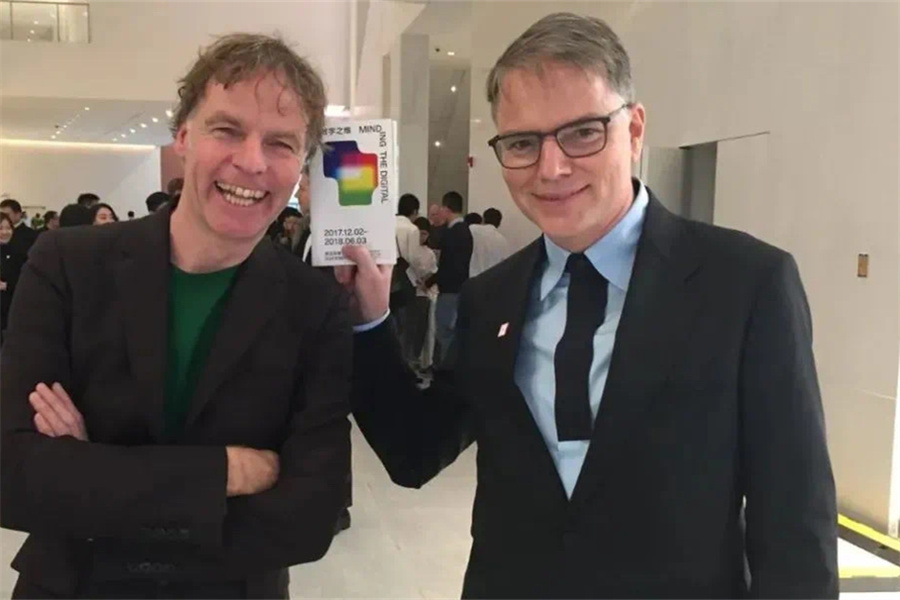
Ole 与一位荷兰建筑”火炬手”,MVRDV建筑事务所的创始合伙人之一Winy Maas
Ole and one Dutch“torch bearer”,Winy Maas, founding partner of MVRDV © 网络 internet
Q8:说到大众媒体传播,香港M+博物馆的立面有令人印象深刻的数字媒体与香港岛隔水相望,成为了香港文化实体的不容忽视的一部分。您认为博物馆在城市中拥有数字化和互动式立面有多重要?
When it comes to the mass media communication, the façade of M+ museum in Hong Kong is impressively adorned in digital media, and has become a part of the city‘s cultural identity. How important is it for museums to have digital and interactive facades in the city?
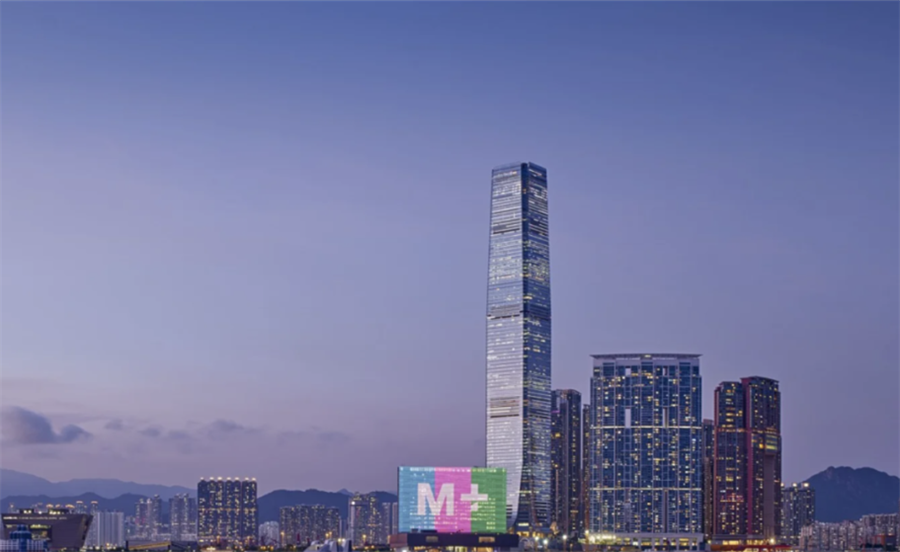
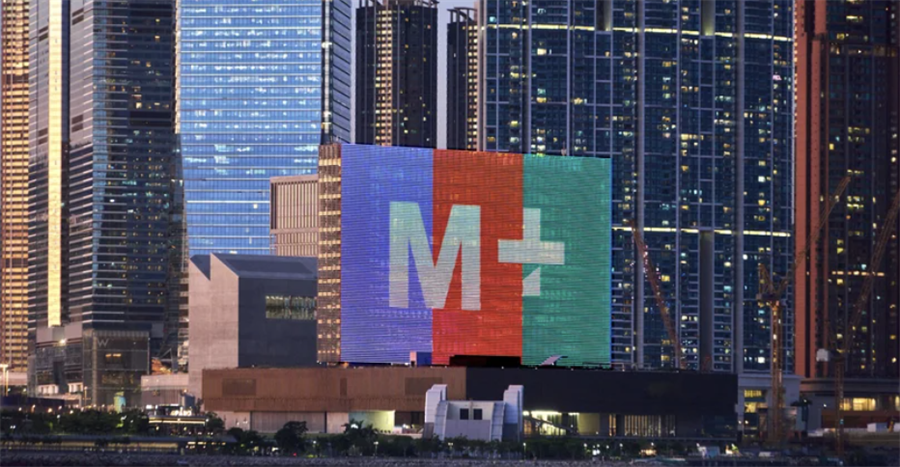
© M+ 博物馆官网 M+ official website
A8:很早以前,我写过关于在建筑物内部使用数字展示面的文章。
几年前,我们有一个叫做 “tran_port_2000”的项目, 展馆不仅可以改变立面上的信息,而且可以改变整个形状,建筑物的形状和体积还可以根据互联网流量而改变。
我们曾经认为,建筑物(尤其是古典建筑)的核心信息需要刻在外部,并且该信息将持续数百年或至少数十年。在我们生活的数字时代里,我们期望信息的展示会更加流畅。所以我认为使用这些媒体屏幕最有趣的方式是,像策划一个空间一样去策划内容。通过时间建立一定的叙事性,并使用屏幕与观众建立起联系,他们可以是任何人,而不仅仅是参观博物馆的观众。数字艺术是一种艺术,策划好这种艺术化的信息,它将对博物馆的运作产生巨大的影响力。而设计互联采取了不同的路线,它的周围被大自然环抱,有非常广阔的空间,离海水如此之近,日夜享受海上吹来的微风,非常舒适。设计互联的建筑,更像是空旷空间里的一个雕塑,客户和建筑师的的愿景也是将其视为一个巨大的公共行为的舞台。博物馆慷慨地将超过 40% 的楼面空间作为公共使用空间,这与普通的房地产或住宅项目投资非常不同,后者对每平方米都会以利润回报率来衡量,这个博物馆是一个例外,也是发展方向的重大选择,是客户想要实现的目标。
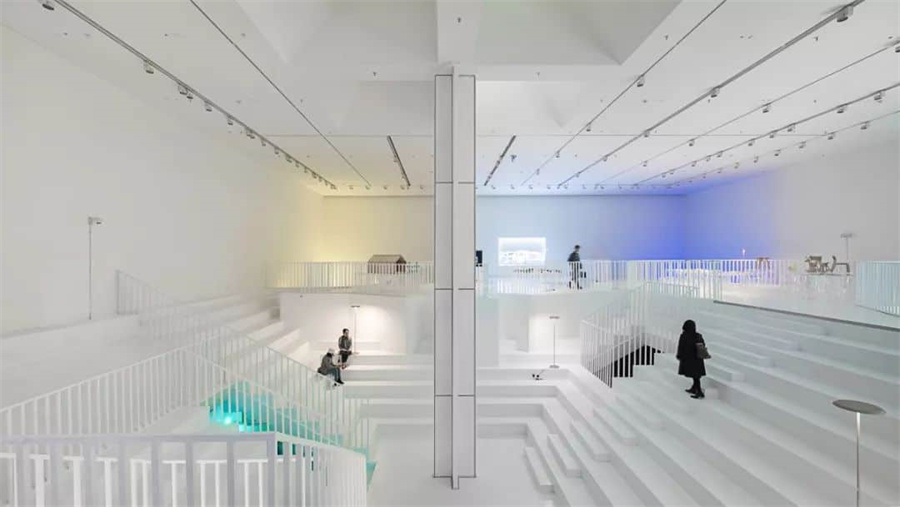
设计互联自主策划展览《数字之维》 ©设计互联 Design Society
现在它是一个原始的、纯白的默认设置,我总是称之为默认设置。这是一个起点。它可以采用一种数字艺术驱动的形式,我们已经做出了一些项目可以证实这一点。我们与来自奥地利的林茨电子艺术节和中央美术学院的团队一起举办了一场精彩的展览,主厅完全被不同的数码作品覆盖,这些作品在某些晚上在外墙上进行电影放映,当地人也可以在没有门票的情况下参观。我还委托一群音乐家创作有趣的作品,将这座建筑改造成某种乐器。空间中的白色雕塑变成了三部曲的动画,首先是针对人们的耳朵而不是他们的眼睛。因此,有一些项目正在酝酿中,而且愿景中有一些东西可能会将这座建筑转变为高度媒介化的存在。以默认设置作为起点,随着许多创作的进行,博物馆将变成一座城市纪念碑,这也是我们想要传达的核心信息,以确保更多的人们能找到通往这个地方的路,同时让人们发现这座博物馆是他们文化体验的源泉。
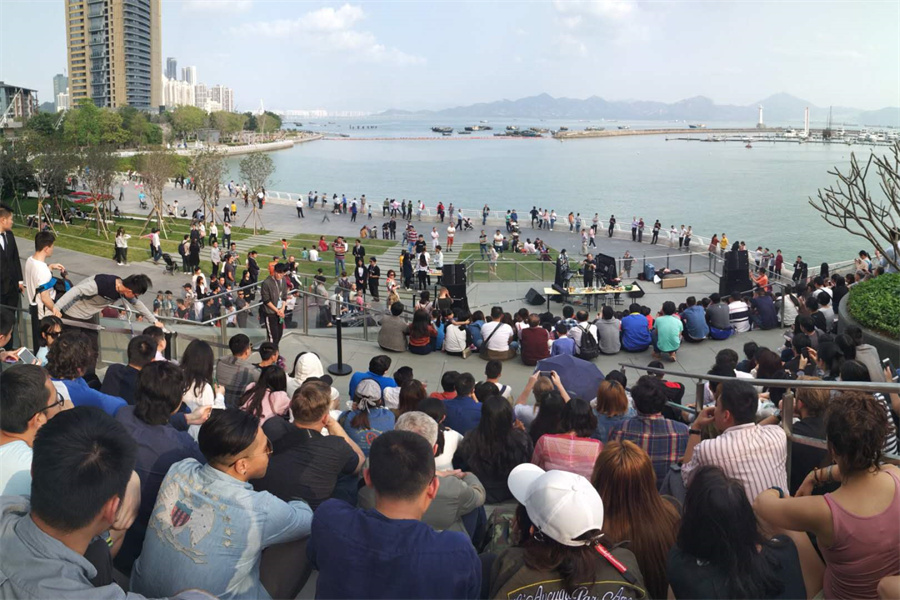
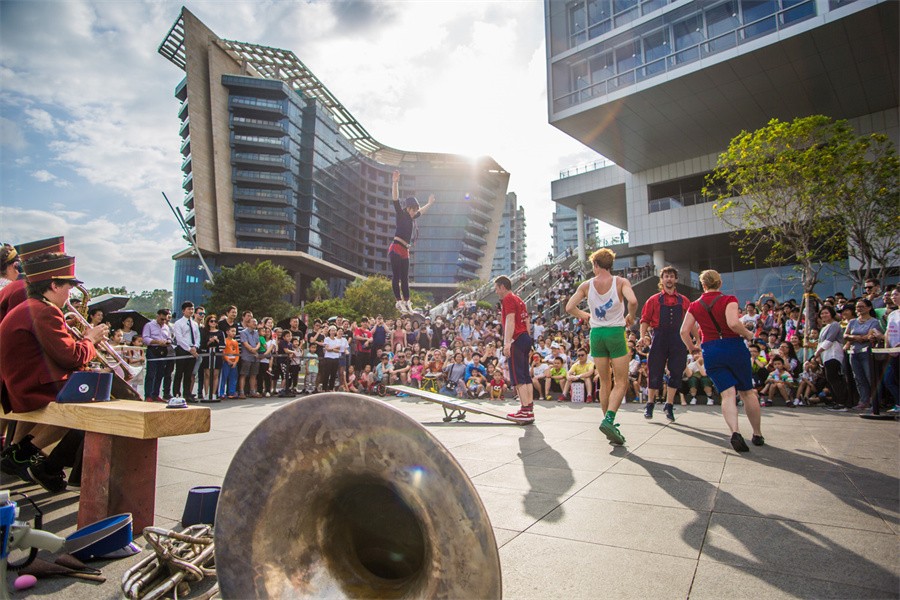
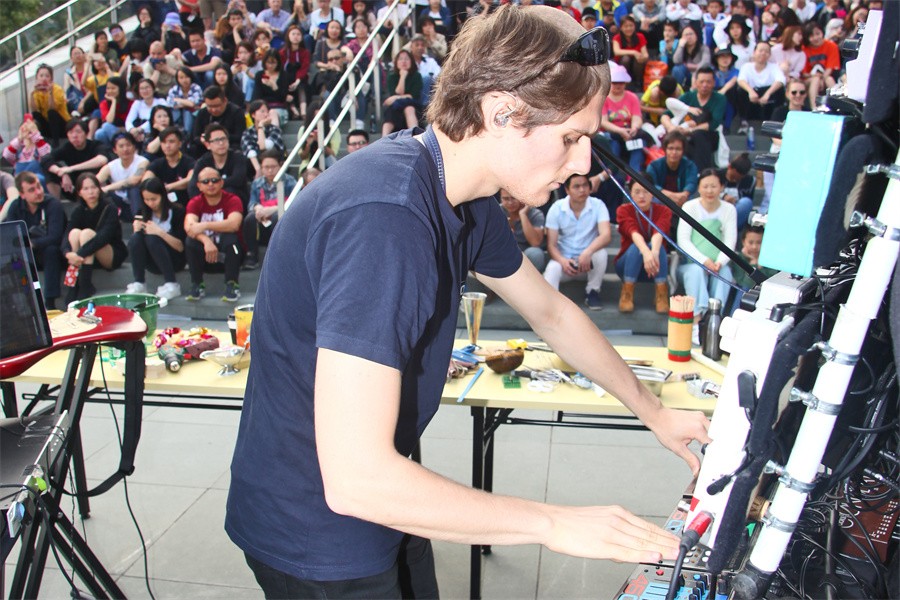
©设计互联 Design Society
I have been dealing with the use of digital display panels in buildings before. We once had project called“trans-ports_2000”, a pavilion not only can change the message on the facade but also alter the entire shape and volume of the building,in response to internet traffic.We used to think that the core information of a building (especially in classical architecture) needs to be engraved on the exterior, to last for decades, if not hundreds of years. The current digital age mindset is to expect a more a fluid graphic display. So I think the most interesting way to use these media screens is to curate it, and build up a certain narrative over time to connect with the target audience. They can be anyone, not just those visiting the museum.
Digital art is also kind of art. The creative planning of the message will have enormous impact on the operation of the museum. Design society adopted different routes for interactive design. A vast space surrounded by an abundance of nature, so close the water, a very comfortable place to enjoy the sea breeze, day and night. The interconnected architecture of Design Society sits more like a sculptural object in space. As such, both architects and visitors regard the ensemble of forms as a stage for exaggerated public statements. The museum generously dedicates more than 40% of floor space to the general public, in stark contrast to conventional real estate or housing developments, which maximizes financial return on every square meter. This museum is a happy exception, inspired by an enlightened development vision shared and endorsed by the users. As sculpture, the building’s default setting, if you will, serves as the canvas or base for a variety of digitally driven art forms adopted over the years. There were already some projects to substantiate this. We had a fantastic exhibition together with Ars Electronica from Austria, where the main hall was completely animated by different works. We also had works projected on the facades on certain evenings, which locals can visit free of charge. I also commissioned a group of musicians to create interesting compositions to transform the building into a music instrument.
The white sculpture in space has become an animation pf the trilogy, initially targeting the ears rather than the eyes. So there is something in the pipeline and there is something in the vision that may transform this building into something highly mediated. With the default setting as the starting point and countless creations in the pipeline, the museum will turn into an urban monument and beacon. That's also the core message that we want to convey to make sure people find their way to the place, a source of their cultural aspirations.
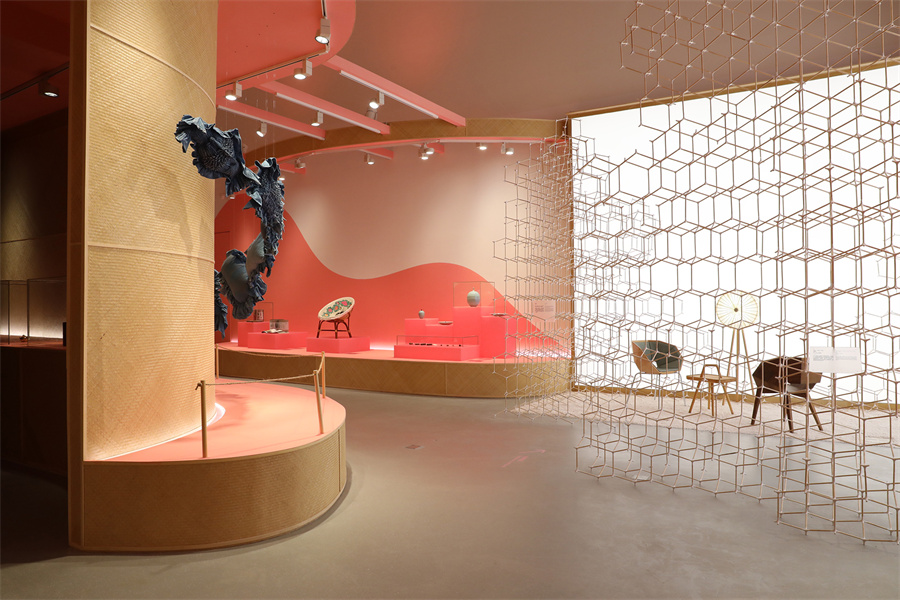
设计互联自主策划展览《造物新世代》 ©设计互联 Design Society
Q9:您是在什么阶段加入博物馆筹备团队的?当时招商蛇口的团队是否清楚他们想要什么,您对此做了什么样的贡献和改变呢?
At what stage did you join the museum developing team? Did Merchants Group team have a clear idea what they wanted and what contribution and change did you make?
A9:我认为他们知道自己想要什么,但究竟如何开发、如何呈现、如何变得具有影响力,尚未明朗,当然也不知道如何执行。
我到了之后,经过多次讨论,我们决定放弃“蛇口设计博物馆”这个名字,原因有几个。 首先,因为具体地名所代表的在地性和历史性虽然重要,但可能不是一个全球目的地的好名字。而且“博物馆”这个称呼更多是关于展示,收藏和整合已经存在的东西。对于这个希望在设计力量和社会需求之中发挥作用的新机构,比如说,产生新概念并改变社会, 我们决定取一个新名字,叫“设计互联”。它的意思是通过设计而联结,通过设计改造社会,并将设计用作动词,而不是名词,所以更像是一种赋能激活,而不是一种整合。所以我们想到了一个平台而不是博物馆的想法。中文里博物馆这个词更多的是关于一个保存伟大而美丽事物的地方,更多的是关于保存和整合。所以西方语境中的博物馆可能仍然意味着它会激发你的灵感。我们需要谨慎选择出正确的措辞,以确保(全球的)人们理解(这家机构)在东西方文化领域里想要扮演的角色。
我认为V&A是一个公共机构,以其知名又重量级的馆藏而盛名于世。尽管招商蛇口是一家通过其多种业务来服务与影响当今社会的大型国企,实际上要将这样一家大公司的注意力集中在文化上,是需要另一种思维方式的。
如果用集团的财力资源一直专注于打造一个收藏,这样做的重点就是从市场上慢慢去获取更多的藏品,丰富这个馆藏,然后展示给大家。这些藏品是普通人永远无法触及的东西,是关于财富的创造和积累。至少我觉得他们的想法不止于此。相反,他们希望创建一个公共领域,人们可以轻松地四处漫游并成为活动的一部分,而不仅仅是消费某种图像。因此,我们也越来越多地谈到了如何吸引来参与者,而不是访客。
I think they knew what they wanted, but it was not clear how it could be developed, presented, and become influential. Nor was it clear, of course, how it could be implemented.
After I arrived, there were many discussions, and we decided to give up the name Shekou Design Museum for several reasons. First of all, although the locality and historicity represented by specific geographical names are important, they may not be a good name for a global destination for this new institution that wants to play a role in the collection between the power of design and societal needs. Because museum very much is, let's say, about display, about collection and about consolidation of what is already there.
When an institution that wants to play a role in giving birth to new concepts and reaching out of society, we decided to come up with a new name that can be loosely translated as Design Society in Chinese, Sheji Hulian. So the idea is connection through design, building society through design, and using design as a verb, more a verb than a noun. It's more about activation than a consolidation. You see, we were convinced museum was not the right word to express this spirit of activation and agendas. So we came to this idea of a platform rather than a museum. In the Chinese language, the word museum, Bo Wuguan, is much more about the preservation of great things, beautiful things, and even more about consolidation. So museum in Western language might still mean something like it inspires you.
You need to be careful in choosing the right wording to make sure that people understand the role you want to play.
I think V&A Museum is a public institution known for its famous collections. While China Merchants Group a is a large state-owned enterprise that is creating society today through its businesses, it takes an alternate way of thinking to direct its focus on culture. If the financial resources of the group is used to build a collection, that is enriched by the market, owned by the group, before it is put on display, these works of art are things that ordinary people can never touch. They are about the creation and accumulation of wealth. At least I don't think they want to just do that. Instead, they want to create a public sphere where people can easily roam around and become part of activities, rather than just consuming images. Therefore, we are also talking more and more about how to attractparticipants that bring something to the table rather than passive visitors.
Q10:中国第一座V&A合作博物馆项目是怎么建成的?
How was the first V&A collaboration museum built in China?
A10:我们像是招商蛇口和V&A之间的桥梁。首先要确保参与方之间建立了一定的信任关系,V&A 在与中国国企的接触中找到某种舒适的交流方式和实现其长远抱负的可能性。另一方面,招商蛇口会明白运营一个文化机构都需要什么。不仅是财务方面,还有团队方面、营销方面、展览设计的质量,所以有很多东西可以向(V&A这样的)机构学习,不断地进行调整而将这些不同的理念和标准结合在一起,并再整合这些理念和标准之后提出最终的概念。
We served as a bridge between Shekou Merchant and V&A. First of all, we made sure a certain level of trust was built into the relationship in which V&A could find comfort and long-term aspirations with a state-owned company. On the other hand, China Merchants understand what it takes to run a cultural institution, not only financially, but also in terms of team, marketing, and the quality of exhibition design. Clearly, there's much to learn from the institutions. To this end, mediation is ongoing to bring these different worlds together, and to put forward a final concept of integrating these standards.
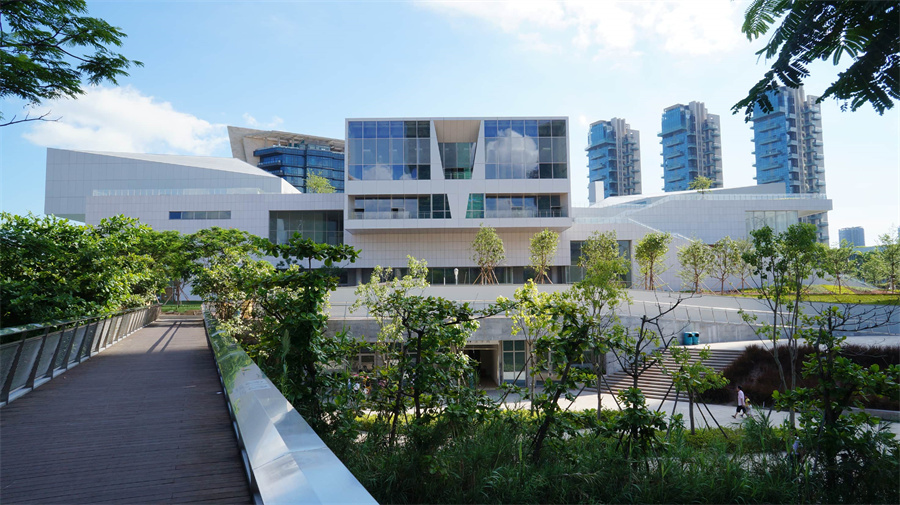
©设计互联 Design Society
Q11:为什么选择 V&A 而不是 MoMA 等其他博物馆?
Why V&A, not other museums such as MoMA?
A11:我认为这是一个非常有趣的选择,我只能推测他们是如何“相互倾心”的。
所以我认为这个项目对我来说有趣的一面是,去做一些不同于许多其他博物馆的事情。V&A对于复刻一个自己的“博物馆中国分馆”并不感兴趣,实际上他们希望成为更大计划的一部分。虽然由中国国企在中国大陆来经营自己的分馆,V&A可能无法完全控制最终的展览等效果,但他们对共同建立新机构所带来的创造性新内容更感兴趣,所以对风险持更开放的态度,这样才促成了这件事的成立。
对招商蛇口来说,风险相对可能会小一些,因为 V&A 的百年声誉是众所周知的。他们(招商蛇口)也投入了大量的研究资源,我的同事赵蓉多次去到V&A实地考察和商谈,为合作铺平了道路。
这其中有很多的工作方式,在这些维度之间需要大量的协调和沟通,这就是为什么我认为我的工作对他们来说是有价值的。
I think it was a very interesting choice and I can only speculate about how they came to love each other.
So I think the motivation behind my support for this project was the opportunity to do something different from what many other museums are doing. V&A was not interested in replicating their own China branch museum. In fact, they to be part of a bigger initiative, even if the risks were greater. Chinese companies would run the local branches. Although V&A couldn’t completely control the final effect, they were much more open to the creative risks that come with the joint venture.
On the other hand, the risk for China Merchants may be relatively small, because V&A’s hundred-year history and reputation is very well known. They invest a lot of research resource as well. My close colleague Zhao Rong went there several times to pave the way for the collaboration.
There were also a lot of alternative modality and alternative ways of working. Hence there was a lot of mediation needed between these dimensions. That's why I could be relevant to them, I think.
Q12:在中国新年期间,您给了您当时的团队成员每人一个橙色的“红包”,而不是中国传统的红包,[橙色通常被认为非常”荷兰“的颜色],在我看来您非常了解双方的文化,这就是为什么您可以为多方带来独特的价值。
During Chinese New Year, you gave your then team members an orange package, instead of the traditional Chinese red package, [Orange being commonly perceived as a very Dutch color]. It seemed to me you understand the culture from both sides very well, which is why you could bring a unique value to the table.
A12:在筹备过程中,最好的部分之一就是与这个设计互联的团队合作。我每天都惊叹于这个团队的力量。看到他们奉献的精神、专业的知识、学习的意愿、合作的意愿,真是令人印象非常深刻,所以我们只用了相对较小的团队就成功地建立了一个完整的机构,这真是太棒了。
One of the best parts of my experience was to work with this team. I was in awe every day and deeply impressed by the power of this team. It was really amazing (to see) the level of dedication, the expertise and the knowledge, the will to learn, the will to collaborate. So with only relatively small team we managed to build an entire institution, this was amazing.
关于 OBJEKT 境界出版社
About OBJEKT Asia Publication
OBJEKT 境界出版社是集出版图书杂志,海内外策展,媒体公关,游学于一身的小众高端综合性文化交流公司。旗下出版 2 本高端精品刊物:来自于荷兰的艺术设计风尚类的《 OBJEKT ASIA 境界》杂志,即 OBJEKT INTERNATIONAL 的亚洲版;以及北京香港马会会所的会员内刊 Harmony(双月刊)(2018-2020)。此外,在艺术领域境界出版社更是积累了丰富的策展经验,如 2017 年 9 月北京设计周期间与荷兰王国驻华大使馆和荷兰各大博物馆合作组织策划落地的《荷兰百年风格派——致敬与回顾大展》,获得了央视重要媒体的多方报道及广大专业及观众的喜爱。
主理人简介
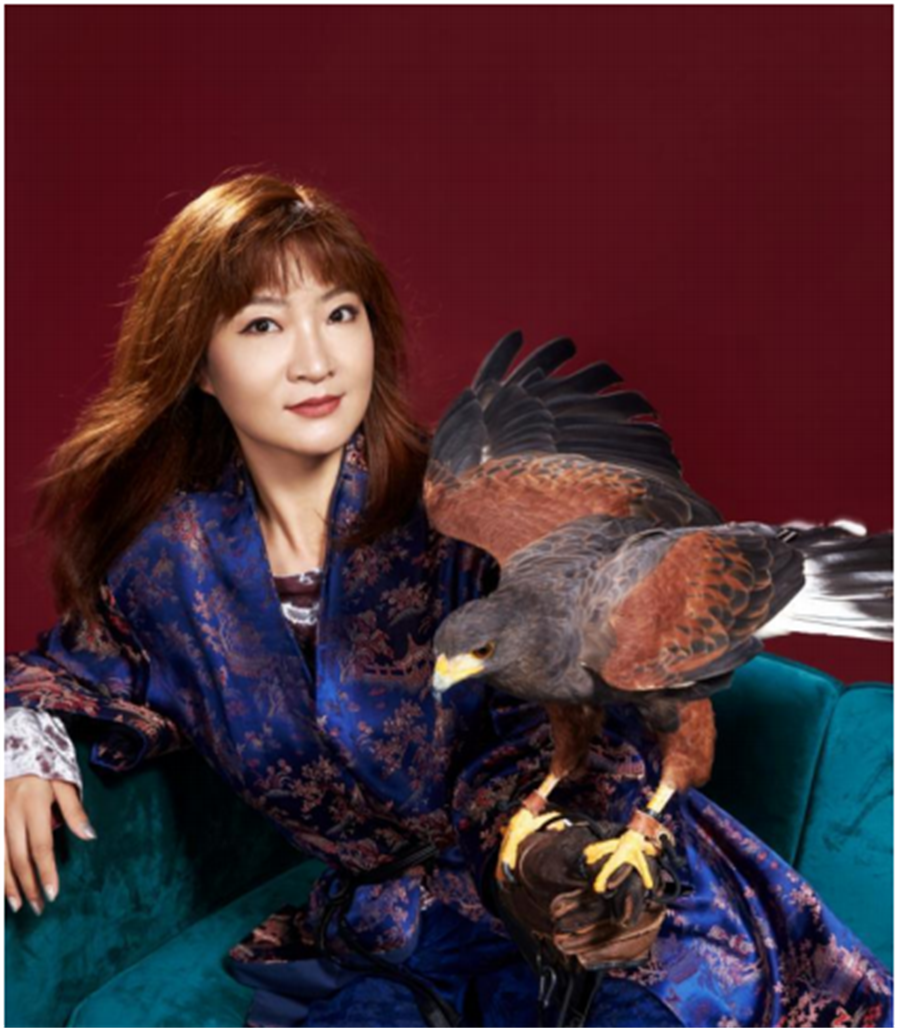
冯辉
Cora Feng
教育及职位:
荷兰代尔夫特理工大学 MBA 科技管理硕士
OBJEKT ASIA 境界杂志亚洲版主编/联合创始人
米兰国际家具展上海展设计卫星展评委之一(2019)
2017 年全国最大的“荷兰百年风格派-回顾与致敬”展览(北京 751)的发起人和策展人
中国室内装饰协会陈设艺术专业委员会副秘书长委员
中央美术学院/城市设计学院//家居产品设计专业/传统造物与应用设计工作室导师
Education and titles:
Master Degree in Management of Technology, TU Delft university, the Netherlands
Editor-in-chief and co-founder of OBJEKT ASIA
ury member of Salone del Mobile Shanghai Satelite. 2019
Curator and Organizer of art&design exhibition [100 years of De Stijl- revisit and reinvent] during Beijing Design Week 2017
Vice secretary of ADCC (Art Display and Decoration Committee , www.adcc.org.cn) under CIDA (China National Interior Decoration Association , founded in 1988,www.cida.org.cn)
Graduation mentor/guest lecturer of CAFA 2021 interior product design

